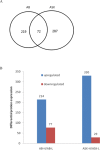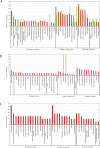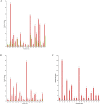Variability in the protein profiles in spermatozoa of two sturgeon species
- PMID: 29077704
- PMCID: PMC5659609
- DOI: 10.1371/journal.pone.0186003
Variability in the protein profiles in spermatozoa of two sturgeon species
Abstract
Conventional sperm analysis (i.e., motility and fertility) has been used to evaluate sperm quality. Understanding the quality of sperm on the molecular level in the sturgeons, Acipenser baerii and A. schrenckii, is essential for the improvement of the conservation of genetic resources and farming performance. In this study, we used the iTRAQ proteomics approach to perform proteomic profiling of spermatozoa associated with sperm quality in sturgeons (Data are available via ProteomeXchange with identifier PXD006108). The results showed 291 and 359 differentially expressed proteins in A. baerii and A. schrenckii, respectively, of which 72 were common to both species and all were upregulated in high quality compared with low quality samples. The differentially expressed proteins were mainly categorized into the generation of precursor metabolites and energy and oxidation, and they were localized to the mitochondria. Three distinguishing pathways, Arginine and proline metabolism, Pyruvate metabolism and the Citrate cycle (TCA cycle) were found to play an important role in energy metabolism, and some substrates could be used in the sperm medium for storage and cryopreservation. The quantity levels of two proteins, CKMT1 and LDHB, were verified by western blot analysis. Moreover, other potential biomarkers involved in oxidation reduction, ubiquitin-proteasome-dependent proteolysis, chaperones and binding activity were also discussed. Our study is the first to use the iTRAQ-based proteomics approach to analyse the sturgeon spermatozoa proteome, and the results that we obtained are valuable for the prediction of sperm quality and reproduction management in these threatened species.
Conflict of interest statement
Figures






Similar articles
-
Protein profile of Dabry's sturgeon (Acipenser dabryanus) spermatozoa and relationship to sperm quality.Anim Reprod Sci. 2019 Feb;201:1-11. doi: 10.1016/j.anireprosci.2018.12.002. Epub 2018 Dec 6. Anim Reprod Sci. 2019. PMID: 30587384
-
Oxidative stress and cryoresistance of sturgeon sperm: A review.Cryobiology. 2023 Dec;113:104594. doi: 10.1016/j.cryobiol.2023.104594. Epub 2023 Oct 15. Cryobiology. 2023. PMID: 37848167 Review.
-
Comparative Proteomic Identification of Mature and Immature Sperm in the Catfish Cranoglanis bouderius.PLoS One. 2016 Mar 10;11(3):e0151254. doi: 10.1371/journal.pone.0151254. eCollection 2016. PLoS One. 2016. PMID: 26964044 Free PMC article.
-
Effect of short-term storage on quality parameters, DNA integrity, and oxidative stress in Russian (Acipenser gueldenstaedtii) and Siberian (Acipenser baerii) sturgeon sperm.Anim Reprod Sci. 2013 Jun;139(1-4):127-35. doi: 10.1016/j.anireprosci.2013.03.006. Epub 2013 Mar 16. Anim Reprod Sci. 2013. PMID: 23602487
-
Sperm proteins in teleostean and chondrostean (sturgeon) fishes.Fish Physiol Biochem. 2009 Nov;35(4):567-81. doi: 10.1007/s10695-008-9261-y. Epub 2008 Sep 23. Fish Physiol Biochem. 2009. PMID: 18810648 Review.
Cited by
-
Metabolomics in sturgeon research: a mini-review.Fish Physiol Biochem. 2024 Aug;50(4):1895-1910. doi: 10.1007/s10695-024-01377-8. Epub 2024 Jul 9. Fish Physiol Biochem. 2024. PMID: 38980504 Free PMC article. Review.
-
Integrated multi-omics analyses reveals molecules governing sperm metabolism potentially influence bull fertility.Sci Rep. 2022 Jun 23;12(1):10692. doi: 10.1038/s41598-022-14589-w. Sci Rep. 2022. PMID: 35739152 Free PMC article.
-
Quantitative proteomic characterization of human sperm cryopreservation: using data-independent acquisition mass spectrometry.BMC Urol. 2019 Dec 16;19(1):133. doi: 10.1186/s12894-019-0565-2. BMC Urol. 2019. PMID: 31842847 Free PMC article.
-
Diversity of sialic acids and sialoglycoproteins in gametes and at fertilization.Front Cell Dev Biol. 2022 Oct 20;10:982931. doi: 10.3389/fcell.2022.982931. eCollection 2022. Front Cell Dev Biol. 2022. PMID: 36340022 Free PMC article. Review.
-
Endocrine-disrupting chemicals in aquatic environment: what are the risks for fish gametes?Fish Physiol Biochem. 2018 Dec;44(6):1561-1576. doi: 10.1007/s10695-018-0507-z. Epub 2018 Jun 11. Fish Physiol Biochem. 2018. PMID: 29948447 Review.
References
-
- Birstein VJ, Bemis WE, Waldman JR. The threatened status of acipenseriform species: a summary In: Birstein VJ, Bemis WE, Waldman JR, editors. Sturgeon Biodiversity and Conservation. Netherlands: Springer; 1997. pp. 427–435.
-
- Alavi SM, Rodina M, Policar T, Kozak P, Psenicka M, Linhart O. Semen of Perca fluviatilis L.: sperm volume and density, seminal plasma indices and effects of dilution ratio, ions and osmolality on sperm motility. Theriogenology. 2007; 68(2): 276–283. doi: 10.1016/j.theriogenology.2007.05.045 - DOI - PubMed
-
- Li P, Hulak M, Linhart O. Sperm proteins in teleostean and chondrostean (sturgeon) fishes. Fish Physiol Biochem. 2009; 35(4): 567–581. doi: 10.1007/s10695-008-9261-y - DOI - PubMed
-
- Li P, Wei Q, Liu L. DNA integrity of Polyodon spathula cryopreserved sperm. J Appl Ichthy. 2008; 24: 121–125.
-
- Watson PF. The causes of reduced fertility with cryopreserved semen. Anim Reprod Sci. 2000; 60–61: 481–492. - PubMed
Publication types
MeSH terms
Substances
LinkOut - more resources
Full Text Sources
Other Literature Sources
Molecular Biology Databases
Miscellaneous

